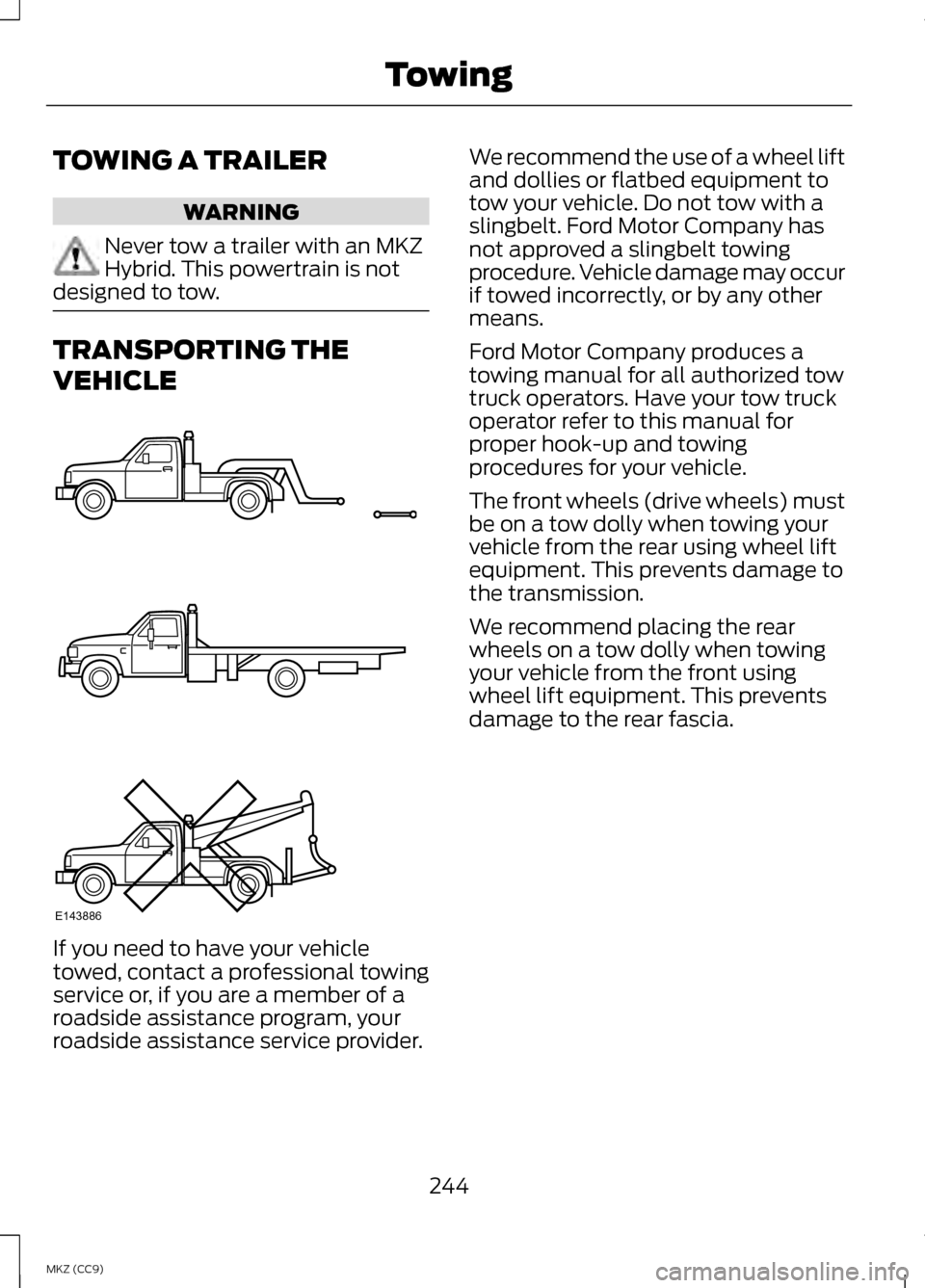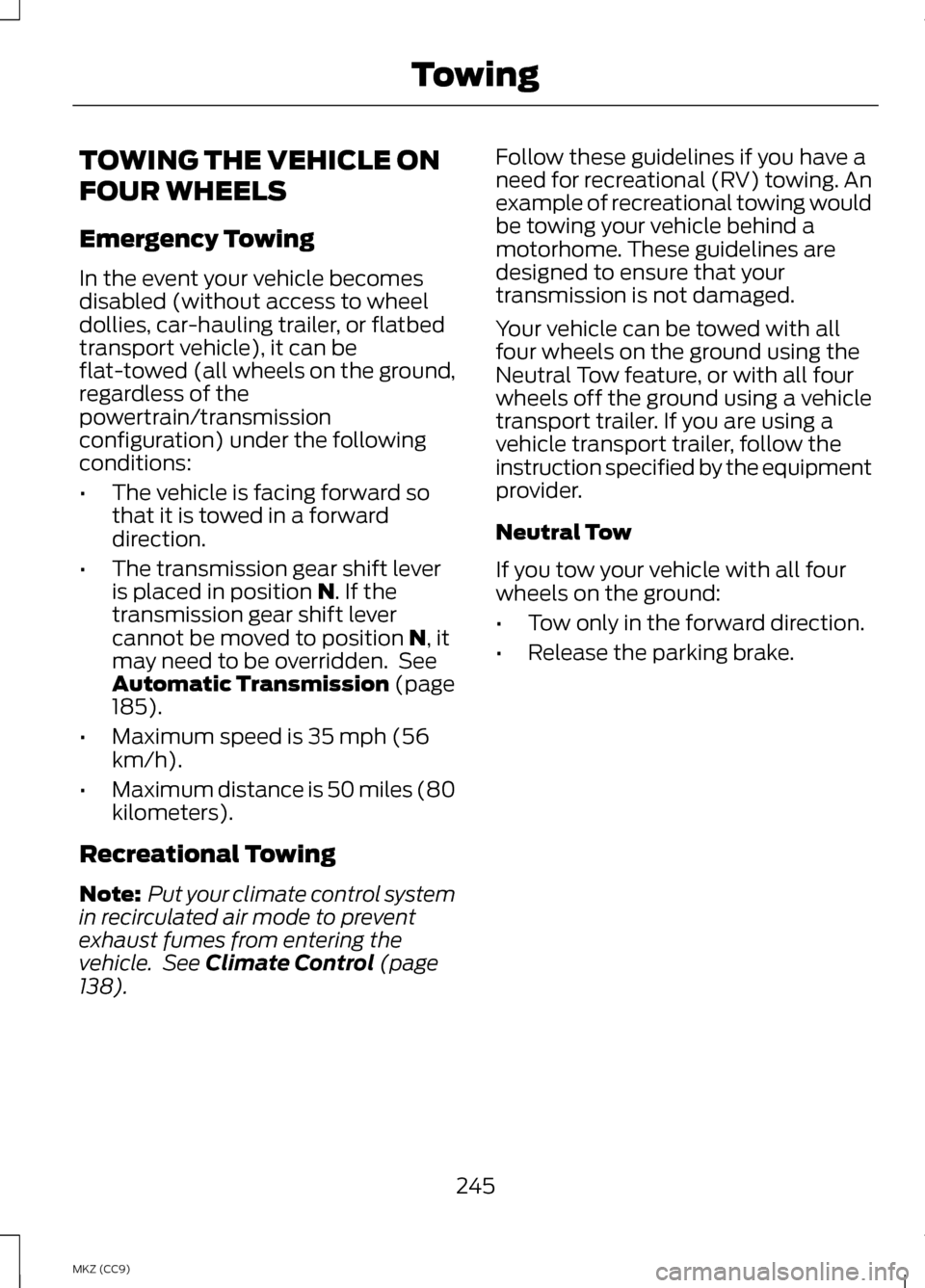Page 242 of 475
WARNING
Exceeding the Safety
Compliance Certification
Label vehicle weight rating limits
could result in substandard
vehicle handling or performance,
engine, transmission and/or
structural damage, serious
damage to the vehicle, loss of
control and personal injury. GCW (Gross Combined Weight)
- is the Gross Vehicle Weight plus
the weight of the fully loaded
trailer. GCWR (Gross Combined
Weight Rating) - is the maximum
allowable weight of the vehicle
and the loaded trailer, including
all cargo and passengers, that the
vehicle can handle without risking
damage. (Important: The towing
vehicle
’s braking system is rated
240
MKZ (CC9) Load CarryingE142524 E143819GCW
GVW
Page 246 of 475

TOWING A TRAILER
WARNING
Never tow a trailer with an MKZ
Hybrid. This powertrain is not
designed to tow. TRANSPORTING THE
VEHICLE
If you need to have your vehicle
towed, contact a professional towing
service or, if you are a member of a
roadside assistance program, your
roadside assistance service provider. We recommend the use of a wheel lift
and dollies or flatbed equipment to
tow your vehicle. Do not tow with a
slingbelt. Ford Motor Company has
not approved a slingbelt towing
procedure. Vehicle damage may occur
if towed incorrectly, or by any other
means.
Ford Motor Company produces a
towing manual for all authorized tow
truck operators. Have your tow truck
operator refer to this manual for
proper hook-up and towing
procedures for your vehicle.
The front wheels (drive wheels) must
be on a tow dolly when towing your
vehicle from the rear using wheel lift
equipment. This prevents damage to
the transmission.
We recommend placing the rear
wheels on a tow dolly when towing
your vehicle from the front using
wheel lift equipment. This prevents
damage to the rear fascia.
244
MKZ (CC9) TowingE143886
Page 247 of 475

TOWING THE VEHICLE ON
FOUR WHEELS
Emergency Towing
In the event your vehicle becomes
disabled (without access to wheel
dollies, car-hauling trailer, or flatbed
transport vehicle), it can be
flat-towed (all wheels on the ground,
regardless of the
powertrain/transmission
configuration) under the following
conditions:
•
The vehicle is facing forward so
that it is towed in a forward
direction.
• The transmission gear shift lever
is placed in position N. If the
transmission gear shift lever
cannot be moved to position
N, it
may need to be overridden. See
Automatic Transmission
(page
185).
• Maximum speed is 35 mph (56
km/h).
• Maximum distance is 50 miles (80
kilometers).
Recreational Towing
Note: Put your climate control system
in recirculated air mode to prevent
exhaust fumes from entering the
vehicle. See
Climate Control (page
138). Follow these guidelines if you have a
need for recreational (RV) towing. An
example of recreational towing would
be towing your vehicle behind a
motorhome. These guidelines are
designed to ensure that your
transmission is not damaged.
Your vehicle can be towed with all
four wheels on the ground using the
Neutral Tow feature, or with all four
wheels off the ground using a vehicle
transport trailer. If you are using a
vehicle transport trailer, follow the
instruction specified by the equipment
provider.
Neutral Tow
If you tow your vehicle with all four
wheels on the ground:
•
Tow only in the forward direction.
• Release the parking brake.
245
MKZ (CC9) Towing
Page 248 of 475
•
Place the vehicle in Neutral Tow
mode by doing the following:
•Put the ignition in accessory
mode (ignition on, engine off).
See Keyless Starting (page
161).
• Select
Neutral Tow in the
information display.
• When prompted by the
information display, press the
brake pedal and select Neutral
on the transmission. Make sure
the parking brake is off. If done
successfully, Neutral Tow
Engaged
appears in the
display.
• Shut the ignition off. See
Keyless Starting
(page 161).
If the process is completed
successfully, the
N on the
transmission slowly blinks and
"Neutral tow engaged" appears
in the information display.
• Do not exceed 70 mph (113 km/h).
• Start the engine and allow it to run
for one minute at the beginning of
each day. With the engine running
and your foot on the brake, shift
into position
D and then into
position R before shifting back into
position
N.
246
MKZ (CC9) Towing
Page 254 of 475

Do not attempt to push-start your
automatic transmission vehicle.
Automatic transmissions do not have
push-start capability. Attempting to
push-start a vehicle with an
automatic transmission may cause
transmission damage.
Preparing Your Vehicle
Note:
Use only a 12-volt supply to start
your vehicle.
Note: Do not disconnect the battery
of the disabled vehicle as this could
damage the vehicle's electrical system.
1. Park the booster vehicle close to the hood of the disabled vehicle
making sure the two vehicles do
not touch. Set the parking brake
on both vehicles and stay clear of
the engine cooling fan and other
moving parts. 2. Check all battery terminals and
remove any excessive corrosion
before you attach the battery
cables. Ensure that vent caps are
tight and level.
3. Turn the heater fan on in both vehicles to protect from any
electrical surges. Turn all other
accessories off.
Connecting the Jumper Cables
Your vehicle has two battery prongs
that are accessible from under the
hood, even though the actual battery
is located in the trunk. Your vehicle
can be jumped the same way
conventional vehicles can be using
these prongs. The illustration below
shows the two connector prongs used
for jump-starting your vehicle.
252
MKZ (CC9) Roadside Emergencies
Page 277 of 475
Protected components
Fuse amp rating
Fuse or relay
number
Passenger airbag disabled indicator,
Transmission range
5A
2
19
Adaptive headlamps
5A 2
20
Humidity and in-car temperature, Rear
climate seats
5A
2
21
Occupant classification sensor
5A 2
22
Delayed accessory (power inverter
logic, moonroof logic)
10A
1
23
Central lock/unlock
30A 1
24
Driver door (window, mirror)
30A 1
25
Front passenger door (window, mirror)
30A 1
26
Moonroof
30A 1
27
THX amplifier
20A 1
28
Rear driver side door (window)
30A 1
29
Rear passenger side door (window)
30A 1
30
Not used (spare)
15A 1
31
GPS, Voice control, Display, Adaptive
cruise control, Radio frequency
receiver
10A
1
32
Radio, Active noise control
20A 1
33
Run/start (fuse #19, 20, 21, 22, 35, 36,
37, circuit breaker)
30A
1
34
Restraints control module
5A 1
35
275
MKZ (CC9) Fuses
Page 288 of 475

You have limited engine power when
in the fail-safe mode, so drive the
vehicle with caution. The vehicle will
not be able to maintain high-speed
operation and the engine will run
rough. Remember that the engine is
capable of completely shutting down
automatically to prevent engine
damage, therefore:
1. Pull off the road as soon as safely
possible and turn off the engine.
2. Arrange for the vehicle to be taken
to an authorized dealer.
3. If this is not possible, wait a short period for the engine to cool.
4. Check the coolant level and replenish if low.
5. Re-start the engine and take your vehicle to an authorized dealer.
AUTOMATIC
TRANSMISSION FLUID
CHECK
Note: Transmission fluid should be
checked by an authorized dealer. If
required, fluid should be added by an
authorized dealer.
The automatic transmission does not
have a transmission fluid dipstick. Have an authorized dealer check and
change the transmission fluid at the
correct service interval. See
Scheduled Maintenance (page 444).
Your transmission does not consume
fluid. However, the fluid level should
be checked if the transmission is not
working properly, (i.e., if the
transmission slips or shifts slowly) or
if you notice some sign of fluid
leakage.
Do not use supplemental transmission
fluid additives, treatments or cleaning
agents. The use of these materials
may affect transmission operation
and result in damage to internal
transmission components.
BRAKE FLUID CHECK
Fluid levels between the MIN and MAX
lines are within the normal operating
range; there is no need to add fluid. If
the fluid levels are outside of the
normal operating range, the
performance of the system could be
compromised; seek service from your
authorized dealer immediately.
POWER STEERING FLUID
CHECK
Your vehicle is equipped with an
electric power steering (EPS) system.
There is no fluid reservoir to check or
fill.
286
MKZ (CC9) Maintenance
Page 290 of 475

Note:
If your battery has a
cover/shield, make sure it is reinstalled
after the battery has been cleaned or
replaced.
Note: See an authorized dealer for low
voltage battery access, testing, or
replacement.
When a low voltage battery
replacement is necessary, see an
authorized dealer to replace the low
voltage battery with a Ford
recommended replacement low
voltage battery that matches the
electrical requirements of the vehicle
To ensure proper operation of the
battery management system (BMS),
do not allow a technician to connect
any electrical device ground
connection directly to the low voltage
battery negative post. A connection
at the low voltage battery negative
post can cause inaccurate
measurements of the battery
condition and potential incorrect
system operation.
Note: If a person adds electrical or
electronic accessories or components
to the vehicle, the accessories or
components may adversely affect the
low voltage battery performance and
durability and may also affect the
performance of other electrical
systems in the vehicle.
For longer, trouble-free operation,
keep the top of the battery clean and
dry. Also, make certain the battery
cables are always tightly fastened to
the battery terminals. If you see any corrosion on the battery
or terminals, remove the cables from
the terminals and clean with a wire
brush. You can neutralize the acid with
a solution of baking soda and water.
When a battery replacement is
required, the battery should only be
replaced with a Ford recommended
replacement battery that matches
the electrical requirements of the
vehicle.
Because your vehicle
’s engine is
electronically-controlled by a
computer, some engine control
settings are maintained by power
from the low voltage battery. Some
engine computer settings, like the idle
trim and fuel trim strategy, optimize
the driveability and performance of
the engine. Some other computer
settings, like the clock and radio
station presets, are also maintained
in memory by power from the low
voltage battery. When a technician
disconnects and connects the low
voltage battery, these settings are
erased. Complete the following
procedure in order to restore the
settings:
1. With the vehicle at a complete stop, set the parking brake.
2. Shift the transmission into P.
3. Turn off all accessories.
4. Step on the brake pedal and start the vehicle.
288
MKZ (CC9) Maintenance